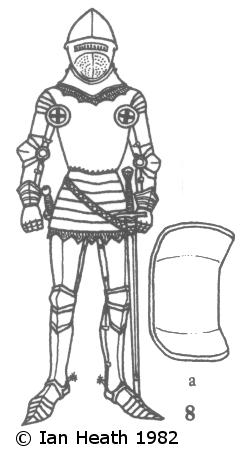SIR THOMAS SWYNBORNE d.1412
An extract from Armies of the Middle Ages, Volume 1by Ian Heath


8. SIR THOMAS SWYNBORNE d.1412
This figure belongs to the era which Ashdown called ‘the surcoatless period’, for a very obvious reason. Because the armour was no longer concealed by the surcoat contemporaries described a man-at-arms thus equipped as alwite, or in French harnois-blanc. Such figures without surcoats began to appear during the second half of the 14th century, but the jupon was only widely discarded from about 1410, disappearing entirely during the 1420s, the first half of the 15th century therefore being the real apogee of the ‘white harness’.
The absence of the surcoat allows us for the first time to see the skirt or fauld of rivetted iron hoops that protected the hips. This was apparently fixed to a leather or strong fabric lining. Below it the mail skirt of his arming doublet (see note 22) can still be seen, the only other places where mail shows being under his gorget and the gussets behind his knees, inside his elbows and covering his armpits, the latter being protected in addition by palettes (basically besagews under a new name), here painted white with a red cross. The fringe of mail visible below the gorget of his ‘great bascinet’ indicates that he must be wearing a mail coif (called in 14th-15th century England a ‘wire hat’), the aventail having now been displaced by the plate gorget. The gorget is in fact part of the helmet, which includes in addition a bevor, or bavière, covering the lower part of the face, this piece of armour deriving its name from the Old French verb baver, meaning ‘to dribble’! The great bascinet appeared c. 1400 and had largely supplanted the ordinary visored bascinet by c. 1420.
No shield is shown in the original brass, of course, but shields like that depicted in 8a were still to be found in use, Henry V himself being shown with one in the decorations of his chantry chapel in Westminster Abbey. This type was an evolution of that carried by figure 7, presenting a more concave surface to the enemy so that his lance was prevented from glancing either up or down, being deflected away to the left instead. The use of shields in mounted combat continued to decline, however, and they are generally only to be found in tournaments by c.1450.